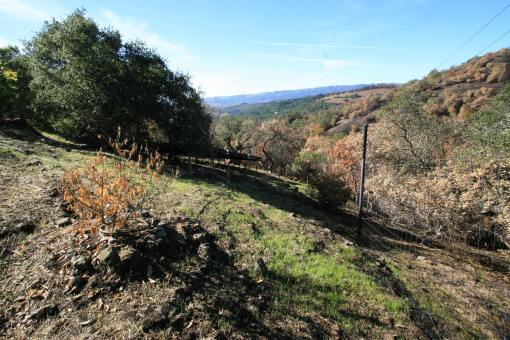
Compare untreated oaks in the background (right) with oaks in the foreground (left) treated with fire mimicry.
In 2009 I was contacted by a property owner who had just purchased a home and several acres of oak forest near the town of Sonoma, CA. The forest had been neglected for many years and was in poor health. There was also a dense growth of underbrush around the trees and many dead limbs on the oaks. I provided him a fire mimicry treatment plan that involved clearing of the underbrush and pruning the oaks, focusing on removing the ladder fuels near the ground. I also proposed to fertilize the oaks with alkaline-rich soil minerals, removed mosses and lichens from the trunks, and applied limewash.
The owner agreed to this plan and during the next couple years I and several colleagues spent many weeks clearing brush, pruning limbs, burning brush piles, and fertilizing a large grove of more than 50 valley oak, blue oak, and coast live oak trees.
Afterwards, in 2015, another property owner in Glen Ellen, CA contracted with me to care for her oaks with fire mimicry. This grove of about 30 oaks was treated in the same manner as described above.
Both of these properties were impacted by the recent wildfires in Sonoma. Yesterday I visited these properties and I’m pleased to report that they sustained very little permanent damage. No structures were lost and nearly all of the oak trees appear to have survived. I estimate that the survival rate of trees on both properties is about 98%, although it will be another year or so before we know the exact percentage.
With regards to the first property, the photos here show that the fire burned the adjacent forest severely, with a complete loss of the forest canopy in places. However, once the fires reached the areas treated with fire mimicry, the severity lessened and fire stayed on the ground. None of the trees in the treated areas experienced a canopy fire. The boundary between the treated and untreated trees, showing this difference in fire severity, can be seen in the above and below photos.
I should add that while this home did not burn, four nearby homes were completely destroyed.
The second property also had no loss of structures and only minor damage to the oaks (see last photo below). The fire did not spread into the canopies and all of the affected oaks will likely recover.
With regards to the “cause” of these severe wildfires, some focus on the source of the initial spark, such as a downed power line or arson. Others point the finger at climate change affecting the health of the forests.
My take, based on the results shown here and elsewhere in the scientific literature, is that the cause of the severe wildfires is due to the suppression of fires and lack of management of the forests. Historically, oak forests were regularly burned by the California native people to enhance the health of the oak savanna ecosystem. Under a frequent burning regime the fires tended to be ground fires, which rejuvenate the soils but do not damage the tree canopies. Without these traditional management practices, our oak forests have become overgrown and stressed. Now-a-days, when fires do burn, they tend to be destructive canopy fires, rather than rejuvenating ground fires.
The oak forests and homes on these properties were saved in spite of adjacent ignition sources from raging fires. Nor did we change the climate. We simply went in ahead of time and mimicked wildfire in these areas. It is clear to me from this and other studies that proper forest management is fundamental in solving the wildfire problem in California.

Fence line of property separating burned/untreated oak forests (right) and unburned/treated oak forests (left).
Read the rest of this entry »






Recent Comments